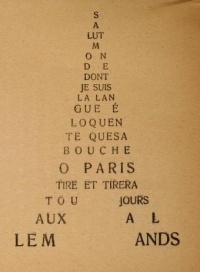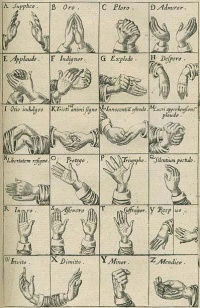Graphic design
From The Art and Popular Culture Encyclopedia

|
Canon: Saul Bass, Roman Cieślewicz, Neville Brody, Dick Bruna, Milton Glaser, Théophile Steinlen |
.png)

(poster by PAL (Jean de Paléologue), printed by Paul Dupont)


|
Related e |
|
Featured: |
Graphic design is the process of communicating visually using text and images to present information. Graphic design practice embraces a range of cognitive skills, aesthetics and crafts, including typography, visual arts and page layout. Like other forms of design, graphic design often refers to both the process (designing) by which the communication is created and the products (designs) which are generated.
Contents |
History
While Graphic Design as a discipline has a relatively recent history, with the term 'graphic design" first coined by William Addison Dwiggins in 1922, graphic design-like activities span the history of humankind: from the caves of Lascaux, to Rome's Trajan's Column to the illuminated manuscripts of the Middle Ages, to the dazzling neons of Ginza. In both this lengthy history and in the relatively recent explosion of visual communication in the 20th and 21st centuries, there is sometimes a blurring distinction and over-lapping of advertising art, graphic design and fine art. After all, they share many of the same elements, theories, principles, practices and languages, and sometimes the same benefactor or client. In advertising art the ultimate objective is the sale of goods and services. In graphic design, "the essence is to give order to information, form to ideas, expression and feeling to artifacts that document human experience."
Medieval
Medieval religious illuminated manuscripts combine text and images. Among these books are the Gospel books of Insular art, created in the monasteries of the British Isles. The graphics in these books reflect the influence of the Animal style associated with the "barbarian" peoples of Northern Europe, with much use of interlace and geometric decoration.
Placards and posters
Placard and posters existed from the ancient times. The Persian reliefs that depicted the important historical events; and the Greek axons and the Roman Albums, with their decorative designs and announcements, were quite similar to today's posters. In ancient Greece the name of athletes, and games schedules were written on columns that were slowly turning on an axis. Romans used whitewashed walls in their markets in which sellers, money lenders, and slave traders wrote their announcements and advertised for their products, and to attract the attention of customers they added attractive designs to their announcements.
Emergence of the print and design industry
Around 1450, Johann Gutenberg's printing press made books widely available in Europe. The book design of Aldus Manutius developed the book structure which would become the foundation of western publication design. With the development of the lithographic process, invented by a Czech named Alois Senefelder in 1798 in Austria, the creation of posters become feasible. Although handmade posters existed before, they were mainly used for government announcements. William Caxton, who in 1477 started a printing company in England, produced the first printed poster.
Engraving
Engraving is the practice of incising a design onto a hard, usually flat surface, by cutting grooves into it. The process was developed in Germany in the 1430s from the engraving used by goldsmiths to decorate metalwork. Engravers use a hardened steel tool called a burin to cut the design into the surface, most traditionally a copper plate. Gravers come in a variety of shapes and sizes that yield different line types.
Etching
Etching is the process of using strong acid or mordant to cut into the unprotected parts of a metal surface to create a design in intaglio in the metal. This technique is believed to have been invented by Daniel Hopfer (c. 1470-1536) of Augsburg, Germany, who decorated armour in this way, and applied the method to printmaking. Etching soon came to challenge engraving as the most popular printmaking medium. Its great advantage was that, unlike engraving which requires special skill in metalworking, etching is relatively easy to learn for an artist trained in drawing.
The advent of printing
During the Tang Dynasty (618–907) between the 4th and 7th century AD, wood blocks were cut to print on textiles and later to reproduce Buddhist texts. A Buddhist scripture printed in 868 is the earliest known printed book. Beginning in the 11th century, longer scrolls and books were produced using movable type printing making books widely available during the Song dynasty (960–1279). Sometime around 1450, Johann Gutenberg's printing press made books widely available in Europe. The book design of Aldus Manutius developed the book structure which would become the foundation of western publication design. This era of graphic design is called Humanist or Old Style.
Emergence of the design industry
In late 19th century Europe, especially in the United Kingdom, the movement began to separate graphic design from fine art.
In 1849, Henry Cole became one of the major forces in design education in Great Britain, informing the government of the importance of design in his Journal of Design and Manufactures. He organized the Great Exhibition as a celebration of modern industrial technology and Victorian design.
From 1891 to 1896, William Morris' Kelmscott Press published books that are some of the most significant of the graphic design products of the Arts and Crafts movement, and made a very lucrative business of creating books of great stylistic refinement and selling them to the wealthy for a premium. Morris proved that a market existed for works of graphic design in their own right and helped pioneer the separation of design from production and from fine art. The work of the Kelmscott Press is characterized by its obsession with historical styles. This historicism was, however, important as it amounted to the first significant reaction to the stale state of nineteenth-century graphic design. Morris' work, along with the rest of the Private Press movement, directly influenced Art Nouveau and is indirectly responsible for developments in early twentieth century graphic design in general.
Twentieth century design
The name "Graphic Design" first appeared in print in the 1922 essay "New Kind of Printing Calls for New Design" by William Addison Dwiggins, an American book designer in the early 20th century.
Raffe's Graphic Design, published in 1927, is considered to be the first book to use "Graphic Design" in its title.
The signage in the London Underground is a classic design example of the modern era and used a typeface designed by Edward Johnston in 1916.
In the 1920s, Soviet constructivism applied 'intellectual production' in different spheres of production. The movement saw individualistic art as useless in revolutionary Russia and thus moved towards creating objects for utilitarian purposes. They designed buildings, theater sets, posters, fabrics, clothing, furniture, logos, menus, etc.
Jan Tschichold codified the principles of modern typography in his 1928 book, New Typography. He later repudiated the philosophy he espoused in this book as being fascistic, but it remained very influential. Tschichold, Bauhaus typographers such as Herbert Bayer and Laszlo Moholy-Nagy, and El Lissitzky have greatly influenced graphic design as we know it today. They pioneered production techniques and stylistic devices used throughout the twentieth century. The following years saw graphic design in the modern style gain widespread acceptance and application. A booming post-World War II American economy established a greater need for graphic design, mainly advertising and packaging. The emigration of the German Bauhaus school of design to Chicago in 1937 brought a "mass-produced" minimalism to America; sparking a wild fire of "modern" architecture and design. Notable names in mid-century modern design include Adrian Frutiger, designer of the typefaces Univers and Frutiger; Paul Rand, who, from the late 1930s until his death in 1996, took the principles of the Bauhaus and applied them to popular advertising and logo design, helping to create a uniquely American approach to European minimalism while becoming one of the principal pioneers of the subset of graphic design known as corporate identity; and Josef Müller-Brockmann, who designed posters in a severe yet accessible manner typical of the 1950s and 1970s era.
The growth of the professional graphic design industry has grown in parallel with the rise of consumerism. This has raised some concerns and criticisms, notably from within the graphic design community with the First Things First manifesto. First launched by Ken Garland in 1964, it was re-published as the First Things First 2000 manifesto in 1999 in the magazine Emigre 51 stating "We propose a reversal of priorities in favor of more useful, lasting and democratic forms of communication - a mindshift away from product marketing and toward the exploration and production of a new kind of meaning. The scope of debate is shrinking; it must expand. Consumerism is running uncontested; it must be challenged by other perspectives expressed, in part, through the visual languages and resources of design." Both editions attracted signatures from respected design practitioners and thinkers, for example; Rudy VanderLans, Erik Spiekermann, Ellen Lupton and Rick Poynor. The 2000 manifesto was also notably published in Adbusters, known for its strong critiques of visual culture.
See also
Related disciplines
Related topics




